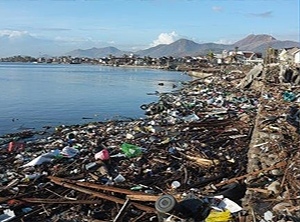PLASTICS AND HEALTH
California to test drinking water for microplastics / Study says particles travel world's air currents / Most continents net importers of microplastics from marine waste
 Particles from marine waste can spread to land through the air, according to a study (Photo: Basel Convention) |
The US state of California is scheduled to introduce a testing standard and requirements for four years of checking drinking water for microplastics by 1 July 2021, and such guidelines would be considered by many as the first in the world to be issued by a government agency. The State Water Resources Control Board also said it may decide to issue quantitative guidelines that could include a notification level for consumers.
In 2020, the board became the first US state agency to define microplastics, choosing to approve this proposed draft: “‘Microplastics in Drinking Water’ are defined as solid polymeric materials to which chemical additives or other substances may have been added, which are particles which have at least three dimensions that are greater than 1nm and less than 5,000 micrometers.”
The state noted that polymers derived in nature that have not been chemically modified – other than by hydrolysis – are excluded, a clause believed to eliminate bioplastics from the definition.
Scientists continue to debate the impact of microplastics on health, and how they enter the bodies of living beings varies. Some particles are said to gain access through inhalation, and a recent study says microplastics can span the globe as they ride the planet’s wind currents.
In 2020, the board became the first US state agency to define microplastics, choosing to approve this proposed draft: “‘Microplastics in Drinking Water’ are defined as solid polymeric materials to which chemical additives or other substances may have been added, which are particles which have at least three dimensions that are greater than 1nm and less than 5,000 micrometers.”
The state noted that polymers derived in nature that have not been chemically modified – other than by hydrolysis – are excluded, a clause believed to eliminate bioplastics from the definition.
Scientists continue to debate the impact of microplastics on health, and how they enter the bodies of living beings varies. Some particles are said to gain access through inhalation, and a recent study says microplastics can span the globe as they ride the planet’s wind currents.
Marine waste makes landfall
“We found a lot of legacy plastic pollution everywhere we looked; it travels in the atmosphere and it deposits all over the world,” said Janice Brahney, an assistant professor of natural resources at US-based Utah State University and lead author of the study, titled “Constraining the Atmospheric Limb of the Plastic Cycle” and conducted in conjunction with Cornell University. Brahney directed a study that in 2020 found the tiny plastic fragments in remote areas of US national parks (see Plasteurope.com of 30.06.2020).
She said old polymer waste continues to contribute to the spread of microplastics. “This plastic is not new from this year. It’s from what we’ve already dumped into the environment over several decades.” Researchers say if the plastics are small enough, they can ride the jet stream and land on another continent.
And plastics waste in water is impacting everyone, according to Natalie Mahowald, a professor at Cornell. “Using our best estimate of plastic sources and modeled transport pathways, most continents are net importers of microplastics from the marine environment. This underscores the cumulative role of legacy pollution in the atmospheric burden of plastic.”
The study said results suggest atmospheric microplastics in western US are primarily derived from secondary re-emission sources including roads (84%), the ocean (11%), and agricultural soil dust (5%).
She said old polymer waste continues to contribute to the spread of microplastics. “This plastic is not new from this year. It’s from what we’ve already dumped into the environment over several decades.” Researchers say if the plastics are small enough, they can ride the jet stream and land on another continent.
And plastics waste in water is impacting everyone, according to Natalie Mahowald, a professor at Cornell. “Using our best estimate of plastic sources and modeled transport pathways, most continents are net importers of microplastics from the marine environment. This underscores the cumulative role of legacy pollution in the atmospheric burden of plastic.”
The study said results suggest atmospheric microplastics in western US are primarily derived from secondary re-emission sources including roads (84%), the ocean (11%), and agricultural soil dust (5%).
20.05.2021 Plasteurope.com [247664-0]
Published on 20.05.2021
